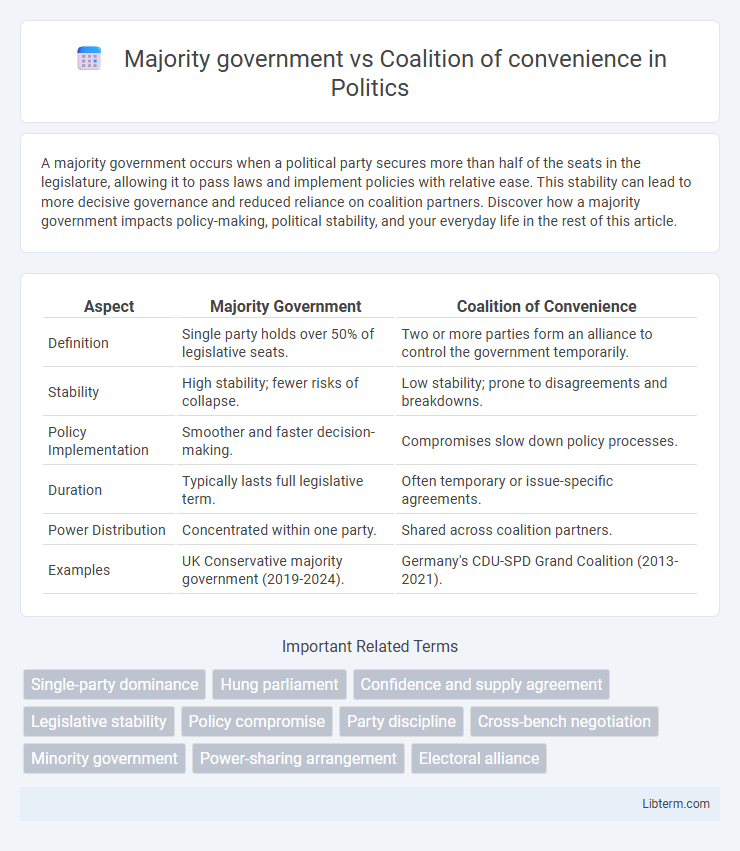A majority government occurs when a political party secures more than half of the seats in the legislature, allowing it to pass laws and implement policies with relative ease. This stability can lead to more decisive governance and reduced reliance on coalition partners. Discover how a majority government impacts policy-making, political stability, and your everyday life in the rest of this article.
Table of Comparison
| Aspect | Majority Government | Coalition of Convenience |
|---|---|---|
| Definition | Single party holds over 50% of legislative seats. | Two or more parties form an alliance to control the government temporarily. |
| Stability | High stability; fewer risks of collapse. | Low stability; prone to disagreements and breakdowns. |
| Policy Implementation | Smoother and faster decision-making. | Compromises slow down policy processes. |
| Duration | Typically lasts full legislative term. | Often temporary or issue-specific agreements. |
| Power Distribution | Concentrated within one party. | Shared across coalition partners. |
| Examples | UK Conservative majority government (2019-2024). | Germany's CDU-SPD Grand Coalition (2013-2021). |
Defining Majority Government and Coalition of Convenience
A majority government occurs when a single political party holds more than half the seats in a legislative body, enabling it to pass legislation without support from other parties. A coalition of convenience is formed when multiple political parties join forces temporarily, often prioritizing mutual interests or power over ideological alignment to achieve a working majority. Majority governments typically ensure stability and streamlined decision-making, while coalitions of convenience may face challenges due to differing party agendas and reduced policy coherence.
Formation Processes: Majority vs Coalition
A majority government forms when a single party wins more than half the seats in the legislature, enabling straightforward legislative control and policy implementation. In contrast, a coalition of convenience arises when multiple parties, often with differing ideologies, unite temporarily to achieve a parliamentary majority, requiring negotiation and compromise to maintain governance. The majority government relies on electoral dominance, whereas coalition formation depends on strategic alliances and power-sharing agreements.
Stability and Longevity of Governments
Majority governments typically exhibit greater stability and longevity due to a single party holding a clear parliamentary majority, enabling consistent policy implementation and reducing the risk of internal disputes. Coalition governments, especially coalitions of convenience, often face challenges in maintaining unity because of differing party agendas, which can lead to frequent conflicts and shorter government durations. The inherent tensions in coalition partnerships increase the likelihood of early elections or government collapse compared to the relative cohesiveness of majority rule.
Policy Making and Decision Speed
Majority governments enable faster decision-making and streamlined policy implementation due to unified party control, minimizing negotiation delays. Coalitions of convenience often experience slower policy processes as diverse parties must compromise, leading to negotiations and potential gridlock. The stability of majority governments typically results in consistent policy direction, while coalition governments face challenges in maintaining consensus on key legislative agendas.
Accountability and Transparency
Majority governments typically offer higher accountability and transparency due to clear leadership and direct voter mandate, enabling decisive policy implementation and straightforward responsibility attribution. Coalition governments of convenience often face challenges in maintaining transparency, as power-sharing arrangements can obscure accountability with negotiated compromises and competing party interests. The complexity of coalition agreements may result in diluted policy clarity, making it harder for the public to hold specific actors responsible for governance outcomes.
Representation and Inclusivity
A majority government ensures stable governance by reflecting a clear mandate from the electorate, offering consistent policy implementation with direct accountability. In contrast, a coalition of convenience often arises from strategic negotiations rather than shared ideology, potentially compromising representational authenticity and inclusivity. While majority governments prioritize decisive leadership, coalitions can enhance inclusivity by incorporating diverse perspectives, though at times risking inefficiency and diluted policy focus.
Party Discipline and Internal Dynamics
Majority governments benefit from strong party discipline, as a single party holds sufficient seats to pass legislation without reliance on external support, ensuring cohesive policy implementation and streamlined decision-making. In contrast, coalitions of convenience often face challenges in maintaining party discipline due to differing agendas among multiple parties, leading to frequent negotiations and compromises that can weaken internal unity. The internal dynamics of coalitions demand constant management to balance diverse interests, whereas majority governments typically experience more stable internal cohesion.
Crisis Management Effectiveness
Majority governments exhibit higher crisis management effectiveness due to streamlined decision-making and unified policy execution, enabling rapid response to emergencies. In contrast, coalitions of convenience often face internal disagreements and slower consensus-building, reducing their ability to implement timely and cohesive solutions during crises. Studies indicate that stable majority administrations outperform coalition governments in maintaining public confidence and delivering consistent crisis communication.
Voter Preferences and Democratic Mandate
Majority governments reflect clear voter preferences through the direct electoral mandate, enabling decisive policy implementation and political stability. Coalitions of convenience often emerge when no single party commands majority support, potentially diluting voter intent by merging divergent platforms primarily for governance rather than ideological alignment. These coalitions may face challenges in sustaining a strong democratic mandate as compromises can obscure distinct policy positions, affecting voter trust and electoral accountability.
Case Studies: Global Examples and Outcomes
Majority governments, as seen in the United States and India, provide stable governance with clear legislative mandates, enabling decisive policy implementation and reduced political gridlock. Coalition governments of convenience, such as Italy's numerous post-war administrations or Belgium's multiple-party coalitions, often emerge from fragmented parliaments and can lead to policy compromises, extended negotiation periods, and sometimes governmental instability. Case studies reveal that while majority governments facilitate efficient decision-making, coalition governments promote inclusiveness and representation but may struggle with coherence and sustained policy agendas.
Majority government Infographic

 libterm.com
libterm.com